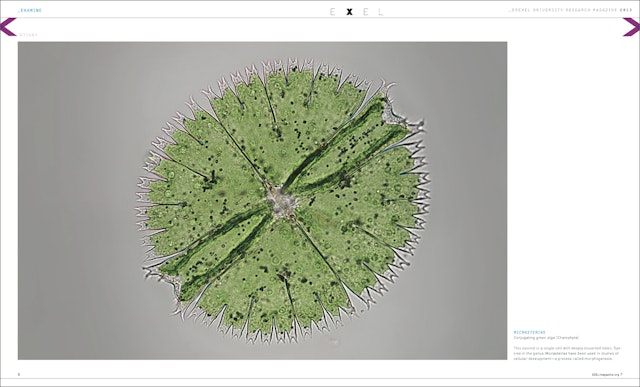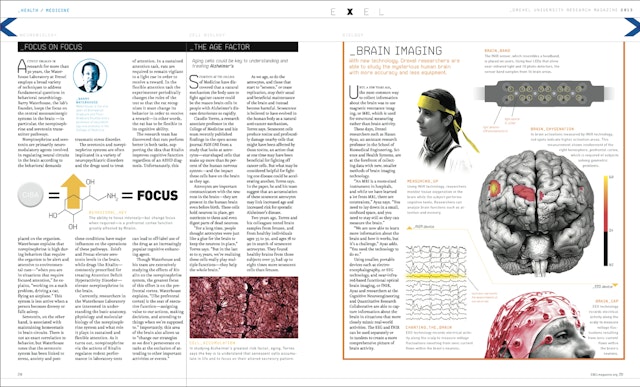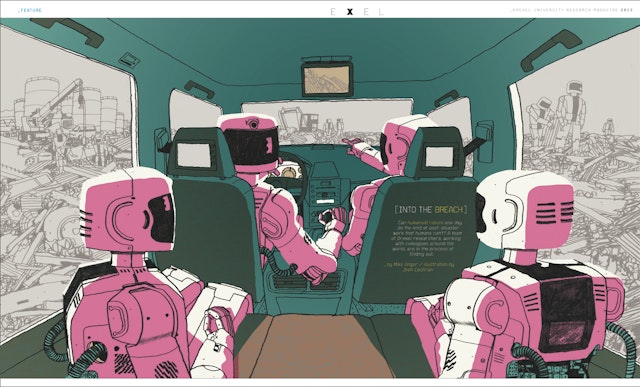





The new magazine also uses the letter "X," found in the middle of the university's name, as a distinctive identity device on the cover and throughout the publication.






Like the premiere issue, the second edition of EXEL features a wide array of visually dynamic scientific photography, illustration and infographics used in modern, inventive layouts to express Drexel's rich research narratives.






Partner has developed a new research magazine for Drexel University located in Philadelphia. The publication (named by Pentagram) is called EXEL, a moniker derived from the last four letters of the word Drexel. The new magazine also uses the letter "X," found in the middle of the university's name, as a distinctive identity device on the cover and throughout the publication. Pentagram has since designed the 2012, 2013, and 2014 issues of the magazine.
Founded in 1891 by Anthony J. Drexel, an accomplished financier and philanthropist, Drexel is a top-ranked, comprehensive university recognized for its experiential learning through cooperative education, its commitment to cutting-edge academic technology and its growing enterprise of use-inspired research. With more than 24,500 students Drexel is one of the nation's largest private universities. Drexel's commitment to research has established the school's reputation as a place where discoveries are made and ground-breaking research leads to innovative solutions. In 2010 John Fry was appointed Drexel University's 14th President and he continued the ambitious expansion of the university's campus and programs initiated by his predecessor. In 2011 Drexel acquired The Academy of Natural Sciences in Philadelphia, the oldest natural history museum in America. The partnership created an international powerhouse for discovery in the natural and environmental sciences. One of President Fry's strategic goals was for Drexel to do a better job getting the word out about the university's strength in research and that's when the call came into Pentagram to help the university develop a new, one-of-a kind, research magazine.
The inaugural issue, out in 2012, was large format and very image driven. The first eight pages of the publication were devoted to surprising, and oddly beautiful, electron microscope imagery presented as full spreads with short explanatory text. The overarching design philosophy throughout EXEL is to emphasize the actual research, the visually dynamic specimens and technologies, and to downplay the typical head-shots of the researchers. The launch issue of EXEL has an embarrassment of riches when it comes to interesting research imagery. It includes an eight-page feature on a band of very "robot-like" robots who play Beatles songs and a story on real beetles, the powerful rhinoceros beetle to be exact, who are being studied by a team of Drexel scientists to learn lessons about the aerodynamics of aircraft flight. There's a piece about the morality of punishment with two powerful full page illustrations by Brad Holland, one of the top illustrators in the world, and a haunting, but gorgeous, digital x-ray image of fish specimens. The cover and a twelve-page gallery titled "Beauty in a Box" feature the visually stunning Titian R. Peale Butterfly and Moth Collection, one of the oldest entomological collections in North America, housed at Drexel's Academy of Natural Sciences. Peale's collection, which the obsessive naturalist carefully displayed in a unique two-sided box configuration, was expertly photographed for EXEL by frequent National Geographic contributor Robert Clark.
The second edition of EXEL hit mailboxes in 2013. It features an eye-catching school of fish swimming about on its cover. The magazine's distinctive cover format unfolds to reveal the word DREXEL, a large graphic letter "X" and 23 exotic fish representing a sampling of species native to Brazil's imperiled Xingu River, including Peckoltia sabaji, named after Academy of Natural Sciences of Drexel University Ichthyology Collection Manager Mark Sabaj Perez. Like the premiere issue, the second edition of EXEL features a wide array of visually dynamic scientific photography, illustration and infographics used in modern, inventive layouts to express Drexel's rich research narratives.
The 2013 edition opens with an eight page image-driven sequence called EXAMINE featuring four surprisingly beautiful photographs of green algae as revealed under a microscope. The microscopic views of the everyday species, barely visible to the naked eye, are presented large-scale and one image per spread. The opening spread for a story on Malaria research titled "In the Red" also features a macro image of a tiny blood-engorged mosquito that takes on a menacing but graphically pleasing aspect because of its scale. An accompanying infographic, playful but informative, reveals the actual size of the little disease-carrying pest. A 10-page treatment of the cover feature called "Race Against Time" presents the researcher's reference photographs of fish in a scientific but artful layout that would feel comfortable in any contemporary art gallery. The issue also utilizes illustration effectively with contributions by top-notch illustration talents Josh Cochran, Simon Pemberton and Edel Rodriguez.
The third edition of EXEL features an eye-catching shot of PVS pipe on its cover. The magazine's distinctive cover format unfolds to reveal the name Drexel, a large graphic letter "X," and a striking image of the blue pipe.
Office
- Austin